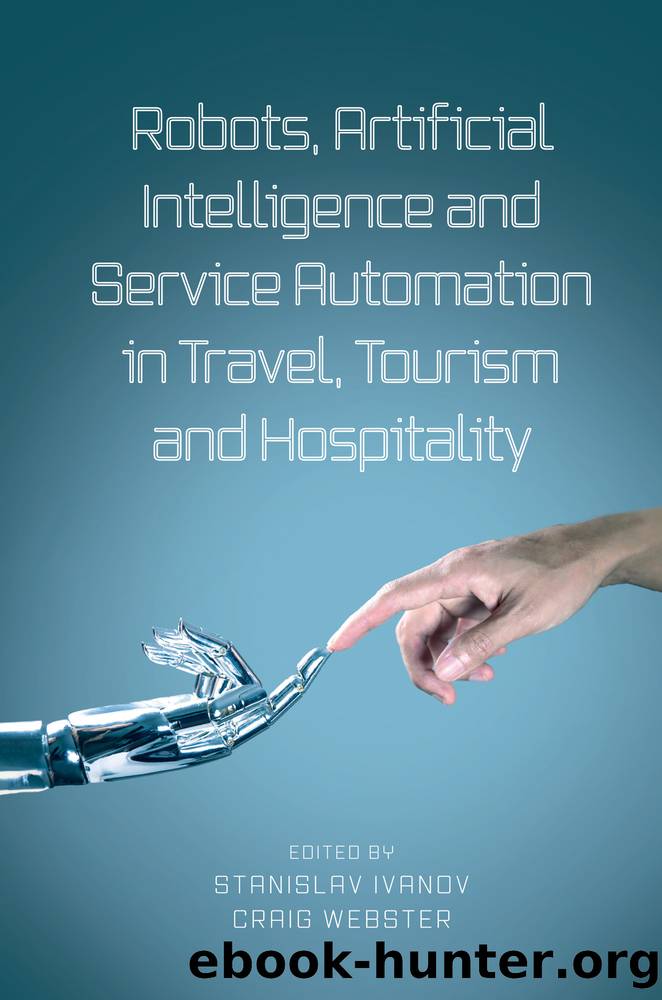Robots, Artificial Intelligence and Service Automation in Travel, Tourism and Hospitality by Ivanov Stanislav; Webster Craig;

Author:Ivanov, Stanislav; Webster, Craig;
Language: eng
Format: epub
Publisher: Emerald Publishing Limited
Published: 2019-09-08T16:00:00+00:00
Robots, Artificial Intelligence and Service Automation in Travel,
Tourism and Hospitality, 123â133
Copyright © 2019 by Emerald Publishing Limited
All rights of reproduction in any form reserved
doi:10.1108/978-1-78756-687-320191007
Chapter 8
Greggg: A Scalable High-performance, Low-cost Hospitality Robot
Sam R. Thangiah, Michael Karavias, Ryan Caldwell, Matthew Wherry, Jessica Seibert, Abdullah Wahbeh, Zachariah Miller and Alexander Gessinger
Introduction
The task of determining what type of a robot to use in the hospitality industry requires consideration of two factors: what is the robotâs required hospitality task and what are the costs and types of robots available commercially that would fit the hospitality task? As few commercially available robots fit precisely with the desired hospitality task, if no commercially available robot fits the task, the available commercial robots would require expensive customization leaving the user extremely dependent on the company manufacturing the robot for both parts and expansion. A recent example was when a decade-old autonomous robot in the artificial intelligence and robotics laboratory needed a new motherboard, and the company manufacturing the robot wanted US $1,600 to replace the old motherboard available from the robot manufacturer. A different vendor had the same motherboard for US $300. Commercial robots are exorbitantly priced and do not allow for scalability and innovative expansions. This expense and scalability was the impetus for building and programing Greggg, using easily obtained hardware and software without paying exorbitant prices each time a change was required to the robotâs hardware or software.
This research is on the hardware and software design and implementation of an expandable, scalable, high-performance, low-cost robot for diverse hospitality tasks. Low cost, in this chapter, is associated with a robot that costs US $2,000 or less. Greggg was implemented using off-the-shelf hardware. Its vision processing uses Deep Learning algorithms and its navigation strategies draw on intelligent heuristics. Currently, Greggg can give tours to prospective students on campus and navigate inside buildings. In addition, it is being programed to act as a docent for a local museum. This chapter explains Gregggâs hardware and software architecture.
Next section âLiterature Reviewâ discusses the use of robots for hospitality tasks. Section âHardware Architecture of Gregggâ provides hardware details of the robot. Section âHardware and Software Integrationâ describe the interface between the hardware and software and software architecture of Greggg, respectively. Section âTasks Performed by Gregggâ lists the capabilities of Greggg for use in varied hospitality tasks. Section âFuture Workâ lists the future work to be done with Greggg and the last section is the conclusion.
Download
This site does not store any files on its server. We only index and link to content provided by other sites. Please contact the content providers to delete copyright contents if any and email us, we'll remove relevant links or contents immediately.
| AI & Machine Learning | Bioinformatics |
| Computer Simulation | Cybernetics |
| Human-Computer Interaction | Information Theory |
| Robotics | Systems Analysis & Design |
Algorithms of the Intelligent Web by Haralambos Marmanis;Dmitry Babenko(7852)
Hadoop in Practice by Alex Holmes(5660)
Jquery UI in Action : Master the concepts Of Jquery UI: A Step By Step Approach by ANMOL GOYAL(5512)
Life 3.0: Being Human in the Age of Artificial Intelligence by Tegmark Max(4507)
Functional Programming in JavaScript by Mantyla Dan(3723)
The Age of Surveillance Capitalism by Shoshana Zuboff(3422)
Big Data Analysis with Python by Ivan Marin(3009)
Blockchain Basics by Daniel Drescher(2891)
The Rosie Effect by Graeme Simsion(2708)
WordPress Plugin Development Cookbook by Yannick Lefebvre(2602)
Hands-On Machine Learning for Algorithmic Trading by Stefan Jansen(2518)
Applied Predictive Modeling by Max Kuhn & Kjell Johnson(2478)
Dawn of the New Everything by Jaron Lanier(2438)
Test-Driven Development with Java by Alan Mellor(2378)
The Art Of Deception by Kevin Mitnick(2297)
Data Augmentation with Python by Duc Haba(2224)
Rapid Viz: A New Method for the Rapid Visualization of Ideas by Kurt Hanks & Larry Belliston(2195)
Human Dynamics Research in Smart and Connected Communities by Shih-Lung Shaw & Daniel Sui(2178)
The Infinite Retina by Robert Scoble Irena Cronin(2175)
